Introduction
Hello everyone! I am appreciative to continued that they offer a variety of courses for continuing education for therapists, and I am happy to be a part of that. We are going to talk today about supporting infants with visual impairments and their journey into feeding. The bottom line is that we are going to try to understand why children with visual impairments have some feeding challenges and how can we help them learn to love food and mealtime?
The Framework
- Feeding is a relationship that depends on the abilities and characteristics of both the parent and the child.” Ellyn Satter (Child of Mine, 2000)
- Vision challenges can interfere with feeding. Interferences with feeding can interfere with parent-child relationships.
The framework that we are going to build all of our ideas on is one that I think is really important. Feeding is a relationship, and Ellen Satter said it well. She said, "It depends on both the abilities and the characteristics of both the parent and the child." And if you think about it, children who have visual challenges have different abilities coming into the mealtime. We know that visual challenges can interfere with feeding, but we also know that these interferences with feeding can interfere with the parent-child relationship. So, it is very important that we support families whose children have visual challenges to understand this, and we really work to bring the parent and child together.
What Do Children Learn Through Vision?
- They see the world around them
- They learn about their family and the people in their world
- They see colors and shapes and learn relationships of objects
- They learn the communication of body language
- Vision gives us a reason to move and reach out beyond themselves
What do sighted babies learn about feeding through their vision?
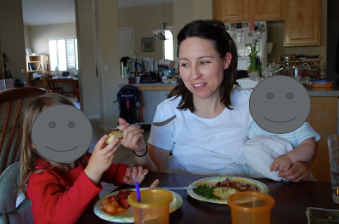
Figure 1. Learning through vision.
They learn lots. They learn to see the world around them. They learn about family and people in their world. They learn to see colors, shapes, and learn about the relationships of objects. They learn the communication of body language and facial expression. Vision gives them a reason to move and reach out beyond themselves.
Eyes Are Preview Sense
- Through vision, we learn who’s who
- Who is familiar and who is not
- We learn at a glance what is safe and what is dangerous
If you think about it, eyes are a preview sense. Through vision, we learn who's who in our environment, who's familiar, and who's not. We learn at a glance what is safe and what is dangerous.
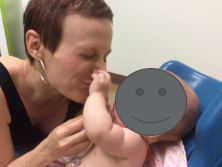
Figure 2. Interaction via vision.
Eyes are a warning system as that is one of their functions.
Feeding and Vision
What Do We Learn With Vision?
- We learn who is our feeder
- We learn that foods look different
- We learn about differences in food textures
- We learn about the pace of the meal, how fast is that food coming, and from what direction
- We learn how a cup, fork, straw, spoon, and plate are used
We learn a lot about feeding through vision. We learn about the feeder. We learn that foods look different. We learn about the pace, or how fast is that food coming at us, and from what direction. We learn about cups, forks, straws, spoons, and utensils. We learn how other people use those utensils. We learn how enthusiastic other people are at trying new things. And, we learn what things in our environment we might want to try.
- We learn that one food is being offered and then our feeder changes it, so we learn change is coming.
- Vision helps us prepare for change!
- Vision allows for previews of sensory change from a distance
- And mealtimes change a lot!
We also learn that one food is now being offered. "The food that is being offered to us right now is baby food pears, and now my feeder just changed those pears to something green. That food that is coming at me right now is a different color, and it may look like a different texture." We learn through vision that change is coming. And, vision helps us prepare for change. Vision allows for previews of sensory change from a distance. It is our distant warning system, and mealtimes change a lot.
Sighted Advantages
- Children who have sight have developmental advantages. Research has been limited.
- “Visual information serves as a stimulus for a child to move and as feedback through which the child learns to correct or improve his or her movement.” Bakke, 2019
- “…Motor development in children with visual impairment is expected to be different from that in typically developing peers. All movements, especially those involving limb- coordination-dexterity and visual-motor control may be modified by reduced visual stimuli.” Bakke, 2019
Sight gives children developmental advantages. Bakke states that visual information serves as a stimulus for a child to move and as feedback through which the child learns to correct or improve his or her movement. In OT school, I remember learning about accommodation. When children are first learning to reach for something, they bump into it and then adapt their motor plan for the shape of that object. Eventually, children learn, "Ah, I am reaching for something that's upright, and I can accommodate. I can turn ahead of time "to make my movement more efficient." When you do not have any vision, you do not get that preview sense and you have to learn to get your feedback from other sensory channels. Also, Bakke told us that motor development in children with visual impairments is expected to be different from that of typically developing peers and that all movement, especially those with limb-coordination-dexterity and visual control, may be modified by reduced visual stimuli. These children are starting off from a different base from which to learn about their world.
Selma Fraiberg
- Pioneer in child development who also studied blindness in the 1970s
- “No possibility of comparing the blind and sighted child in an item by item inventory of prehension and no possibility of fairly scoring these items using sighted child criteria.”
- Fraiberg, S (1977) Insights from the Blind: Comparative studies of blind and sighted infants. New York, New American Library.
Selma Fraiberg, a pioneer in child development studied blindness in the 70s, told us, "There is no possibility of comparing blind and sighted children in an item-by-item inventory of prehension. And, there's no possibility of fairly scoring these items using sighted child criteria." This is why it is complicated trying to do research for a comparison of development for visually impaired children and sighted children. We can learn a lot from watching visually impaired children and from collecting that information.
Adult Support
- They need adult support until they develop independence and confidence in environmental exploration
- The amount of visual loss will influence developmental differences. (Some sight helps!)
- More challenges in fine motor vs gross motor. (Brambring, 2006)
We need to have adults in their environment to support them in learning about their world until they develop independence and confidence to explore independently. The amount of visual loss that a child has is definitely going to affect the amount that their development is affected. Brambring has told us that more challenges are going to be seen in fine motor than in gross motor development, but both are affected.
Developmental Challenges
- Texas School for the Blind and Deaf
- “The Development of Tactile Skills”, by Ann Adkins, Debra Sewell, and Jeri Cleveland
- Visually impaired children … “may be missing crucial information about their world… Visual impairment affects the entire process of information gathering.”
- Tactile information is not the same as visual information gathering
The Texas School for Blind and Deaf Children have some terrific staff who have written an article called, "The Development of Tactile Skills." You can find this online. They talk about how visually impaired children may be missing crucial information about their world and how visual information affects the entire process of gathering information. They go on to say that tactile information is just not the same as visual information gathering.
Tactile Information
- Requires information gathered overtime with systematic exploration
- Cannot be gathered from a distance
- If the child cannot explore that object, his perception of that object may be wrong
- The Elephant Story
- We need to help VI babies get the BIG PICTURE
Tactile information is gathered over time with systematic exploration and cannot be gathered from a distance. It is a close-up sense and not a "preview sense." And, if the child cannot explore that object, his perception of that object may be wrong. You may have heard the elephant story. Three blind people feel an elephant and each comes away with a very different perception from feeling the tail, the leg, and the trunk. We need to help these children to get the big picture of the activities and the sensory world around them and in this case mealtime. We need to make extra effort to give these children more sensory, auditory, and olfactory information so that they can orient themselves to their meal in a much more confident and safe way.
Development Differences
- Wonder Baby published in 2017 “Developmental Charts of Blind and Visually Impaired Babies” by combining information from three sources:
- Developmental Guidelines for Infants with Visual Impairment: A Manual for Early Interventions
- Helping Children Who are Blind
- Children with Visual Impairments
- Were meant to be guidelines
- www.wonderbaby.org
Wonder Baby is an online support group that looks at children with special needs. In 2017, they put together a developmental chart for how children with visual impairments and blindness develop. They gathered information from a number of different sources and made a guideline that you might find helpful. Children with visual impairments have a different starting point for their learning. Let's now look for a few minutes at some of the general stages of development and the ways that we as their grown-ups can help children move forward in their development.
Common Developmental Characteristics of Children Who Are Blind
Prone
- Tend towards delayed in head lifting
- Snuggle into the floor
- Delay moving up against gravity
- We need to help them have a reason to head lift and to weight shift and feel things to reach
In prone, there is a tendency for children with blindness or reduced vision to have delays in head lifting. They tend to snuggle into the floor and have delays in moving up against gravity. This is because vision gives you a reason to lift your head, shift your weight from side to side when you are in prone, and move up against gravity. However, if you have no reason to look up, there will be a tendency to be more snuggled into the floor. We grown-ups can give these kids a reason to head lift.
Supine
- Delayed in trying to move, roll, since vision inspires movement
- Delays in finding feet, flexor development
- Delays in reaching out from supine
- We need to help them feel and learn to move out from their safe center towards rolling, towards toys
- We need to help them learn to explore and find that sensory world around them
We grown-ups can also give children in supine support in moving and rolling since they tend to have a delay in moving out of supine. Again, why? This again is because they are happy laying in supine without a reason to move. In contrast, if you can hear, feel, and be encouraged to move from side to side, you can work towards rolling and searching for toys. We can help children learn to have a reason to move out of their comfortable supine position to find their feet and develop that flexor development that is so important to counterbalance what they are doing in extension.
Sitting
- Tendency to be delayed in getting and out of sitting
- Tend to learn sitting when others sit them
- Once sitting, tend to STAY in sitting. Why would they move out of sitting? Delayed in weight shift from sitting
- We need to help them feel and hear a reason to shift weight in sitting so they can get confident with their balance skills
- We need to give them a reason to learn to get out of sitting and teach getting into sitting
Children with visual impairments that are sat tend to stay in that position. You need a reason to shift your weight and to move out of sitting, and that reason for sighted children is that they see things they want to reach for. For example, they see a toy and reach forward. We need to help these children have confidence in reaching out of those positions and give them a reason to do so.
Play
- Often the child’s favorite toy is their own body (it is what’s close)
- Hands to the midline or near body rather than reaching out
- Solitary play, parallel play is common
- We need to bring the sensory environment to them and help them reach out and play from that safe close to body space
- We need to help them learn interactions with others
During play, visually impaired children's first toys are typically their bodies. They also tend to keep their hands close at the midline. We are going to need to give them reasons to reach out beyond their personal space so their play can be with objects and others within their environment. They can learn how others play by feeling, reaching, touching, and interacting with others. However, on their own, their play is going to be pretty solitary or a parallel play kind of situation.
Crawling
- The tendency to avoid crawling altogether
- Why crawl?
- The hands of protection are busy and the head is leading!!
Crawling is a developmental step that most completely blind children will ignore. Why would you crawl when your hands that usually protect you? If your hands are on the ground and you are trying to move, your head is going to be leading and will be vulnerable. Due to this, this is a stage that is often eliminated altogether.
Walking
- Delay in independent walking
- Tends to walk holding their world
- Think about walking. We have a place to go, a toy to reach for, and reason to move!
- We need to teach skills of walking, modified safety techniques and help them build confidence
There can be a delay in independent walking, and there is a tendency to hang onto the couch, the coffee table, or the wall for a lot longer because it is what they know. We need to teach these children and their families those skills of walking and how to set up an environment for safe upright movement.
Communication
- Sighted babies learn from watching others and from watching the expressions of their parents. They learn what is safe and what is not. What makes parents smile and what does not.
- Those things sighted babies learn from a distance, blind babies need to learn through touch with the help of smell and sound.
Children learn a lot from watching people's faces. Examples are reading faces for surprise, worry, and anger. Visually impaired babies will learn those things through the sound of your voice and through getting to feel the people around them.
Worldview
- The world view tends to be a close space around them
- They need to learn to explore but do it carefully
- Without vision, there can be many unexpected dangers
- And many SENSORY SURPRISES
Children with visual impairments tend to explore what is really close. Without vision, there can be many unexpected dangers for them, and what I am going to call sensory surprises.
Continuum of Visual Challenges

Figure 3. Continuum of visual challenges.
There is a whole continuum of visual challenges from low vision to blind and deaf (see Figure 3). They may have some vision like light and shadow. There are also children that have deafness and blindness. These children are the most severely disadvantaged because they are not even getting auditory cues to help them orient to their world.
Common Extreme Feeding Challenges
There are a number of feeding challenges that children with vision problems can exhibit.
- Caution with change
- Difficulty transitioning from breast or bottle
- Difficulty transitioning to new foods or new textures
- Oral aversion
- Oral refusal
- Oral hypersensitivity
- Gagging
- Vomiting
You have to be cautious with change. They may have difficulty transitioning from breast and bottle it is what they know. They may also have difficulty transitioning to new foods or textures. We can see oral aversion, oral refusal, or hypersensitivity. There are also may be gagging and vomiting. These are very common challenges that these children can have because of the disadvantage they have with exploring the world without vision.
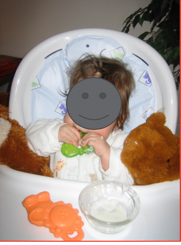
Figure 4. An example of a child with blindness.
Close your eyes, and imagine I am feeding you. You are blind, a year old, in a highchair, and I am offering you baby food apricots. If you know what is expected, you open your mouth each time the food comes at you. But, if I change it up and I offer you blended liver, some of you may have winced or gagged. This is what I am going to call a sensory surprise. You did not expect it. I can take all of you who are probably perfectly good eaters and cause you a level of worry because of this type of sensory surprise. Can you imagine if your mealtime was filled with sensory surprises?
My Experience
- These reactions may well be learned reactions to sensory surprises
- Just like with sighted children, blind children have different temperaments
- Some are more adventuresome and others not so
- Some have had more sensory surprises to figure out
- Babies bring their experiences to the table
- And so do parents…
When I first started working at a school for deaf and blind children 40 years ago, I actually believed that all children with visual impairments had oversensitivity, hyper responses, gagging, and oral aversion. These were the children I saw day in and day out. We were less skilled at helping parents learn how to feed their children back then. However, I realized throughout my career is that a lot of those responses to food can be avoided. I believe children with visual impairments do not have to have sensory oversensitivity if we, from the beginning, help parents know how to present each new sensory change of mealtime in a way that does not have a sensory surprise, the children can trust, feel confident, and not feel worried about their world. Just like children that are sighted have different temperaments, visually impaired children do as well. Some are going to be more adventurous than others, and some have had more sensory surprises to figure out by the time we meet them. Babies bring their experiences to that mealtime as do parents. As Ellen Satter said, feeding is a relationship where children and parents bring their experiences to the table. We want to make sure that those experiences are positive. We want to create a world where each child has a warning system about what is coming next so they do not worry about sensory surprises.
How Can We Help Parents and Babies Avoid Feeding Challenges?
- Build TRUST, TRUST, TRUST
- Feeding is a relationship based on trust
- Parents can be predictable and help the baby use other senses to be prepared for what’s next
- We can help parents move slowly in their introduction of new eating experiences and offer at the baby’s pace
How can we avoid these kinds of feeding challenges? We have to build trust from the beginning. We have to help parents be as predictable as they can be in order to help the babies use their hearing, smell, and touch to be prepared for what is next. We want to help parents move slowly in their introduction of new foods to babies or new eating experiences, and go at the child's pace. We can adapt for those more adventuresome eaters who are saying, "Yeah, I'm ready for that." However, for those babies that are saying, "Wait, I'm just a little worried," we need to go more slowly and give those children more information if they need it.
Help Babies to Trust
- From infancy, intentionally offer feeding experiences with all the senses
- Tell them what to expect
- Show them what to expect
- Help them learn to explore and search reach
- NO sensory surprises
- Watch the baby’s response carefully
- Adapt to their response without PUSHING INTO THEIR worry
- Believe them and trust their response
We want to tell babies what to expect. From the beginning, we are going to intentionally talk about what is happening. In the beginning, infants will not understand all of our words, but things like, "It's time to eat now," "We're going to sit down in the rocking chair," "We're going to have some breastfeeding," or, "We're going to have a bottle," lets the child know what to expect. For example, with breastfeeding, the child is getting a lot of sensory information positionally, but with a bottle, we are going to help the child feel it and know what to expect. We are watching the child's response, and we are not pushing into their worry. If they say they are worried by their action, we are going to believe them, and we are not going to push into what we think they should do for this meal, but rather, we are going to go forward with how they are responding to our presentation.
Division of Responsibility
- Infants
- Parent’s job is to offer the breast or bottle
- Baby’s job to eat until done
- Toddlers
- Parent job to determine the what (menu), where, and when of meals
- Toddler's job to decide how much to eat of the food offered, and IF he wants to eat the food offered.
- The foundation for learning to be a confident and internally motivated eater.
- Based on the work of Ellyn Satter (www.ellynsatterinstitute.org)
I am going to go back for a second to another of the basic foundations and frameworks of feeding babies. We know from the work of Ellen Satter that if the infants and toddlers have a responsibility and parents have a responsibility each step along the way during feeding. It is the parent's job to offer the breast or bottle in the way that the visually impaired child knows it is coming, and it is the child's job to eat until they are finished.
Parents need to offer the food in a way the child can be comfortable with it. The infant is allowed to and encouraged to stop when they are done. We believe them and do not try to make them eat more. When we offer toddlers food, again, it is the parent's job to determine the menu. Parents pick the where of feeding and the when of mealtimes. It is then the toddler's job to decide how much food to eat of the food that is offered, and if they want to eat that food at all. With visual impairments, it is going to be the parent's job to make textures and flavors that are safe, and help the child make the transition to new textures and flavors in a comfortable way.
Offer Vs. Demand
- Offer: Present (something) for (someone) to accept or reject as desired
- Demand: An insistent request made as if by right

Figure 5. Example of an offer.
In the Get Permission Approach workshops that I do, I talk about the difference between offering and demanding. It is our job to offer. "Here sweetheart. Here's some food. Do you like it?" Offer means you are presenting something for someone to accept or reject. A demand is an insistent request that is made as if by a right. When we offer, the baby can accept it by opening their mouth and coming toward that food or say, "Wait, I'm a little worried," and we give the baby the opportunity to not accept that food just yet. If they do not accept it, it is our job to try to figure out why. Was that baby surprised or worried about that food, flavor, or texture? Could it have been too new? Could it have been too different? We are not demanding that they eat the food just because we put it on the spoon. It is an offer, and then we are adjusting the plan.
Positive Vs. Negative Tilt
In the get permission workshops, I also talk about a positive tilt versus a negative tilt (see Figure 6).

Figure 6. Positive vs. negative tilt.
In a positive tilt, the child opens their mouth, comes forward, and says they want the food. In a negative tilt, as you can see in the picture on the right, the child is saying, "No way! I want to get out of the highchair. Leave me alone. We want to make sure that the meal is filled with positive tilts. A sighted baby would come forward if they wanted a particular food and would open their mouth in response to seeing the spoon. Since visually impaired children are not going to have that preview sense, we are going to bring that spoon up to their lip and give the child a moment to be able to smell the food and know it is there, and then open if they want it. We are going to get that positive tilt with some touch support.
Breast Feeding
- Be predictable in the position
- Quietly talk with the baby about the feeding so the baby learns this happy time is one for feeding
- The position and the skin to skin help the baby orient
- Offer the nipple and let the baby indicate readiness with a leaning towards the breast and a mouth opening
- Help them be successful
Let's look at breastfeeding. In breastfeeding, the position is quite predictable. We encourage parents to talk quietly with the baby about the feeding so they learn it is a happy and comfortable time. We are going to help the baby with the skin-to-skin support so they can orient to the nipple to help them be successful in that way.
Bottle Feeding
- Cuddle the baby in a comfortable (predictable) position
- Allow the baby to feel the bottle as a preview
- Offer the nipple at the lips, but give the baby a moment to GIVE PERMISSION, to open indicating readiness. OFFER!
- Do NOT put the nipple in the mouth quickly or unexpectedly
- Let the baby end the meal when done
- Do not force baby to eat more than she wants
In bottle-feeding, we are going to create positional predictability. We set the baby up in a certain position so that they know, "Oh when I'm in this position, they're going to offer me the bottle." We allow the baby to feel the bottle to know it is there. We move the nipple towards the lips, maybe with the baby helping to hold it, so the baby knows how fast the bottle is coming at them. We ask the baby, "Do you want it?" We are waiting for the baby to go, "Oh yeah, I know that and want it." The baby will give permission with a positive tilt which is a coming together of the parent and the baby. We offered, and they said yes. We are not putting the bottle right in the baby's mouth because that is an unexpected sensory surprise. I have known plenty of babies in my career that felt like they had to protect themselves from bottle-feeding because they just never knew when it was coming. It was pretty stressful. We do not want to build up worry starting at the bottle-feeding or breastfeeding stage. Again, the baby is going to end the meal when they are done. We are not going to force them to eat more than they want. If we need to, we could offer more meals during the day to help the baby take in enough during the day, but we are not requiring them to eat a certain amount at each meal. We are letting them stop when they need to. If they pause, we may burp them and let them have a little break and then offer again. However, if they are serious about not wanting it, we will try again later.
Mouthing is Important
- Babies learn a great deal from mouthing fingers and toys
- Helps the baby use fingers to learn
- Helps them get used to textures in the mouth
- And it is an exploration the baby can do on his own
- De-sensitizes mouth
For children with visual impairments, I think the stage of mouthing is very important. Babies can mouth their own fingers to begin learning about their body and their own hands, but also we want them to learn about mouthing different toys because they learn a great deal. They are using their fingers to learn that they can hold something and explore it in their mouth. They also get used to varying textures in their mouth. They learn different oral motor patterns by adapting their mouth around different shapes. They are also learning, "I can do this by myself," and "I can play with a toy on my own." Mouthing objects helps them to desensitize their mouth.
Mouthing Toward Meals
- Mouthing is preparation
- Parents can provide mouthing toys as well as help baby SEARCH REACH for those toys in beginning environment exploration
- Mouthing toys can be explored from a secure position on parent’s lap or in a highchair
- From parent’s lap, baby can smell parent food, feel parent eating, touch parent food and bring fingers to mouth in beginning exploration
Mouthing is also preparation for texture changes during mealtime. There will be spoons, cups, and straws. A baby's mouth can explore these items and not be worried. Parents can provide mouthing toys and help the baby "search reach." What I mean by search reaching is if you touch the baby's hand with the toy and bring it away from them a little bit, you can help tease them towards trying to find it. "Here it is sweetheart," and you are having them reach towards you and the toy to explore a little bit. You can tap on the ground, the highchair, or the table right near them to encourage them to reach towards that sound. We can put mouthing toys around the highchair so that they can begin to get the experience of trying to find them in a set tray that has an edge so things do not fall off. The parent can also eat near the baby so the child is beginning to smell their food, feel their eating, touch the parent's food, and begin to bring their fingers towards their mouth in beginning taste and smell exploration.
Mouthing to Tastes
- It helps babies understand sensory aspects of their world with hands and mouth
- It can include flavors and tastes and the CHILD is in charge
When we help a baby mouth toys the child already knows and is already comfortable with, we can help them begin to have flavors and taste on those toys. For example, in this Tri-Chew in Figure 7, this little guy is exploring on his own.

Figure 7. Baby exploring a taste on his own.
We can dip this toy in breastmilk, juice, or in a soup broth. If the child is comfortable enough with it, we might dip it in a little tiny taste of baby food or a puree. Or, we can rub it on a piece of corn on the cob. In my experience, when we help children have the opportunity to explore flavors and textures themselves, they often are going to be more comfortable than if we bring unexpected sensory surprises to them.
Food as a Mouthing Toy
- Use safe food
- Mouthing toys, as well as safe solids, can be on the highchair tray within reach
- Baby Led Weaning is a nice resource
I like to use mouthing toys as a safe way to explore foods, to explore tastes and textures. I do not like to give them a variety of differently shaped big pieces of food initially because a lot of parents are going to be worried about children biting off foods and choking on chunks. At first, I like to give children that are around four months old, 1/4 of an apple or a large carrot that has been peeled. They are bringing these foods to their mouth as if it is a mouthing toy. They are getting flavors and exploring orally. They are also learning about how their tongue and jaw can interact with these foods. However, at four months, their jaw is not strong enough to bite off a hunk of these foods, and they are not going to get chunks. In contrast, I do not want to give them a cracker right at first because they will be able to break that food up. I am going to give them things they cannot break off. I like "Baby Led Weaning" as a resource, and I am going to talk about that a little bit later.
Food Introductions
- The child is an active participant
- Food on fingers then mouthing toys
- Avoid sensory surprises
When we are introducing foods to babies, we want to make sure that they are active participants as seen in Figure 8.
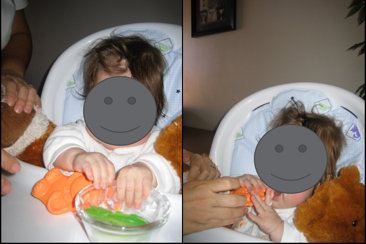
Figure 8. A child participating in feeding.
This little one is being helped to explore that there is food in that bowl. We might help them to dip that mouthing toy that they know. We could help them to smell it, taste it with their fingers, and help them to bring some of that taste to their mouth with a mouthing toy.
Parent Finger Offer
Another way is a parent finger offer (see Figure 9). By that, I mean the parent's fingers are usually friendly and familiar to the child. We can offer a little bit of that flavor on the child's lips.
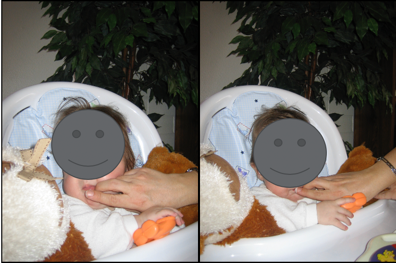
Figure 9. Giving the child a taste of food.
In the picture on the left, this little guy has his head turned away. The parent is offering the food on the side that she wants the child to turn towards. "Hey, sweetheart. Here's the food." She is not putting the food in his mouth when he is turned away. She is teaching him, "When you're ready for it, you can turn towards me and you can open your mouth."
Wait for Permission

Figure 10. Waiting for the mouth to open.
You can see in Figure 10, he is gradually turning his face towards the middle. He is kind of interested, and then when he opens his mouth and says, "You know Mom, I'm ready," she offers it inside his mouth on his tongue. He has had a whole warning system through smell and touch ahead of time and through a predictable presentation pattern.
Tip Toe
- Baby has not seen what to expect
- Baby does not know what to expect
- Baby has no frame of reference
- Ripe environment to create sensory surprises
- So….INCLUDE them in the feel, smell and in telling them about the mealtime, watching THEIR responses
The bottom line is we are tiptoeing. We are not talking about sitting the child in a highchair and introducing foods from a spoon. The baby needs to know what to expect and has to have a frame of reference. We are not going to introduce them to food in such a way as to create sensory surprises.
Start With Familiar
- Once you know the food flavors the baby likes, offer small tastes of purees…on tray and fingers, mouthing toys and then from the spoon
- The spoon can rest in the bowl for baby exploration and pre spoon practice
- Stretch textures as the baby show readiness
- Babies will let you know if they need really careful intros of new food flavors and textures
Once you know what food flavors the child likes, we might offer those on the tray, on fingers, or on mouthing toys. We might put some puree in a bowl with a spoon so that as the child is exploring, they might get food in their mouth from either end. We are not asking for good spoon usage at this time, but we are introducing the spoon as another kind of a mouthing toy. I typically dunk both ends of it in the puree so whatever end they get in their mouth has some taste. We can also help stretch textures as the baby is showing readiness. We can go from a baby food puree kind of texture, like pears, apricots or carrots, and we can gradually add a little bit of rice cereal or some kind of a thickener. We are gradually making changes. However, we want the child to know that those changes are there, and we are going to be really careful that we are not offering a child a whole hunk of scrambled eggs when they are not expecting it. For most of these babies, we are going to offer a soft texture change in smaller increments perhaps with a puree they know. Again, every child is different, but we want to be careful we do not inadvertently cause a gag or an extrasensory surprise.
Rehearsals- Because the Child May Not See The Spoon Coming...
- With any new introduction at mealtimes, be sure to give the child rehearsals (Klein, 2019)
- Rehearsals can be the routine or verbal, smell, sensory signal about the presentation of the food
- Can help the child feel the food and bring a finger or spoon to mouth encouraging the enthusiastic child to feed self
- Offer the spoon of familiar food at the lips and WAIT for the child to GIVE PERMISSION by opening her mouth to take it in
- Offer small amounts
For children with visual impairments, these rehearsals are going to be, "Sweetheart, I'm going to help you. There are pears here and here is some egg." You help them feel it, and you help them take the tiniest little piece of it and bring it towards their mouth themselves. You are not letting them get too much as this is a rehearsal.
Baby-Led Weaning
- Child-directed but the child needs the framework
- Encourages the baby to explore the foods and bring them to their own mouth, with supervision and with caution and safety in mind
- This requires the child to feel safe and excited about textures and be motivated
- It can be done with children with visual impairments but WILL DEPEND ON THE CHILD’S sensory confidence and motor skills
- Baby Led Weaning, Completely Updated and Tenth Anniversary Edition: The Essential Guide-How to Introduce Solid Foods and Help Your Baby Grow Up a Happy and Confident Eater (Rapley and Murkett, 2019)
I really like the concept of "baby-led" weaning. There is a brand new edition out that I like. In this guide, the concept for sighted children is that you are offering foods in a baby-led way. In fact, in full-fledged baby-led weaning, you probably would not even introduce a spoon. You put food on the tray, and you let babies bring it to their mouths. Gradually, as you give them safe foods and safe texture transitions, these babies learn to do a lot of feeding for themselves, and they learn to be in charge of how much they eat and of what goes in their mouths. We still have the same philosophy for children with visual impairments. They should be in charge of what goes in their mouth, but I typically help them to spoon-feed and co-feed when they are trying to bring things to their mouth. I definitely know some visually impaired children where I can dip the spoon in the food and they can bring it to their own mouth. We can help guide them, but a lot of these principles still will work. I think a co-feeding approach where we do some feeding and they do some feeding works as long as we do not put a thing in their mouth before they have told us it is okay. This is a great resource for both sighted children and children with visual impairments.
Hand Under Hand
- Gives sensory feedback about pace
- Helps child learn the motor plan
- Allows for baby to gradually take more control towards independence
I think "hand under hand" is an approach that is very helpful with these babies. See below the video for details of this approach (Video 1).
Video 1.
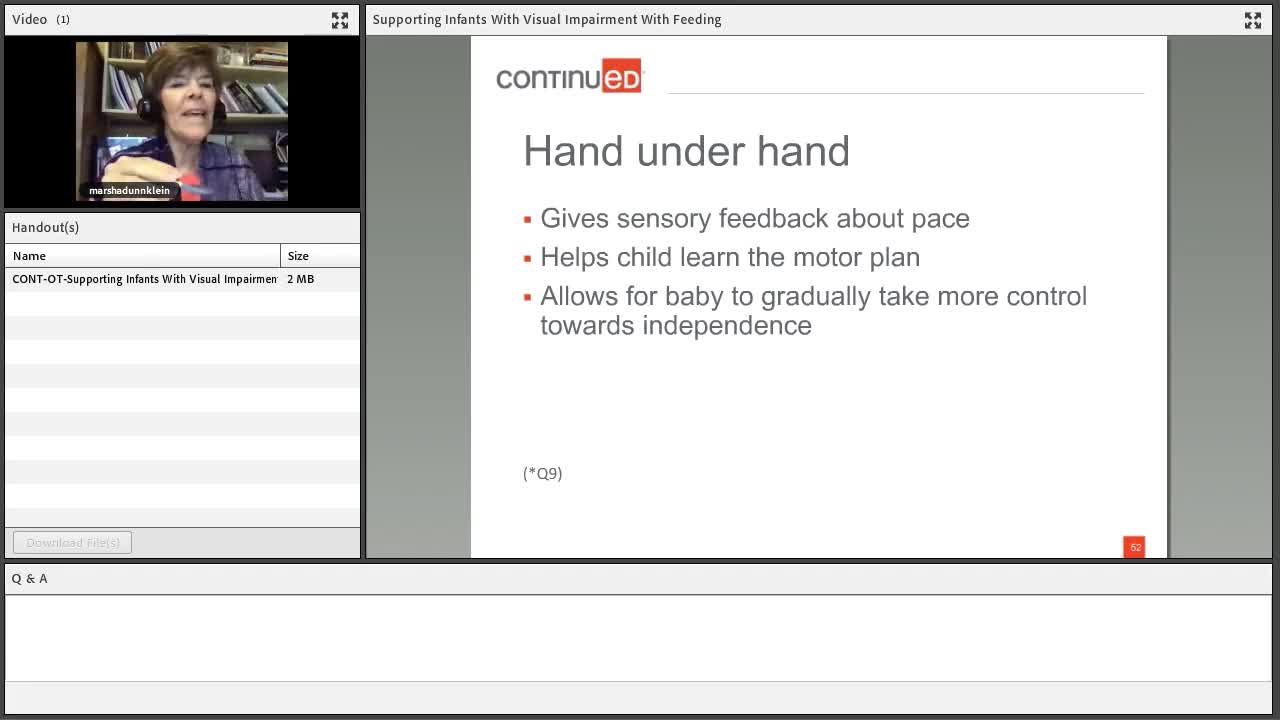
Hand under hand is where I am offering food, and the child's hand is on my hand. As I offer the food to the child, the child knows the food is coming, how fast it is getting there, and the child learns how far the spoon is from the hand and what is coming next.
Spoon Experience
- Once the child is good with mouthing toys, a spoon becomes a mouthing toy
- You can offer it in the bowl or plate and the child will get the experience of picking it up and tasting the food
- Gradually the child will learn to dip into the puree
- …And eventually scoop
Video 2.

Once the child is good at mouthing toys and that spoon becomes the mouthing toy, we are going to offer a bowl with that spoon in it. Or, there may be a couple of spoons in it. Initially, the child is just bringing the mouthing toy or spoon to their mouth. Then gradually, we can help them "dip-dip" so they get the idea that they can get the food on the spoon by getting to the bottom of the bowl. Many children that are visually impaired have to be taught to scoop to reach the food. We see a lot of kids trying to scoop sort of in the air. If from the beginning, we are teaching little one-year-olds to dip-dip to get to the bottom of the bowl, they learn the bottom of the bowl is where the food is.
Spoon Play
- Small spoons that fit baby hands from predictable plates
- Orient to the meal with touch is a rehearsal for more mature eating skills later
- A child can work toward learning to bring fingers and spoons to own mouth while adult co-feed
There are a number of spoons out there that fit babies' hands. I personally think it is pretty important to offer small spoons that are short. This is an EZPZ Tiny Spoon (see Figure 11).

Figure 11. EZPZ Tiny Spoon.
I like it because it's a little tiny person size, and there is not a lot of space here for the child to try to figure out coordination. It is easier to coordinate when the spoon is right near where the hand is. Here is a NumNum® Prespoon GOOtensils in Figure 12.

Figure 12. NumNum® Prespoon GOOtensils.
Here is a video that overviews some of these utensils (Video 3).
Video 3.
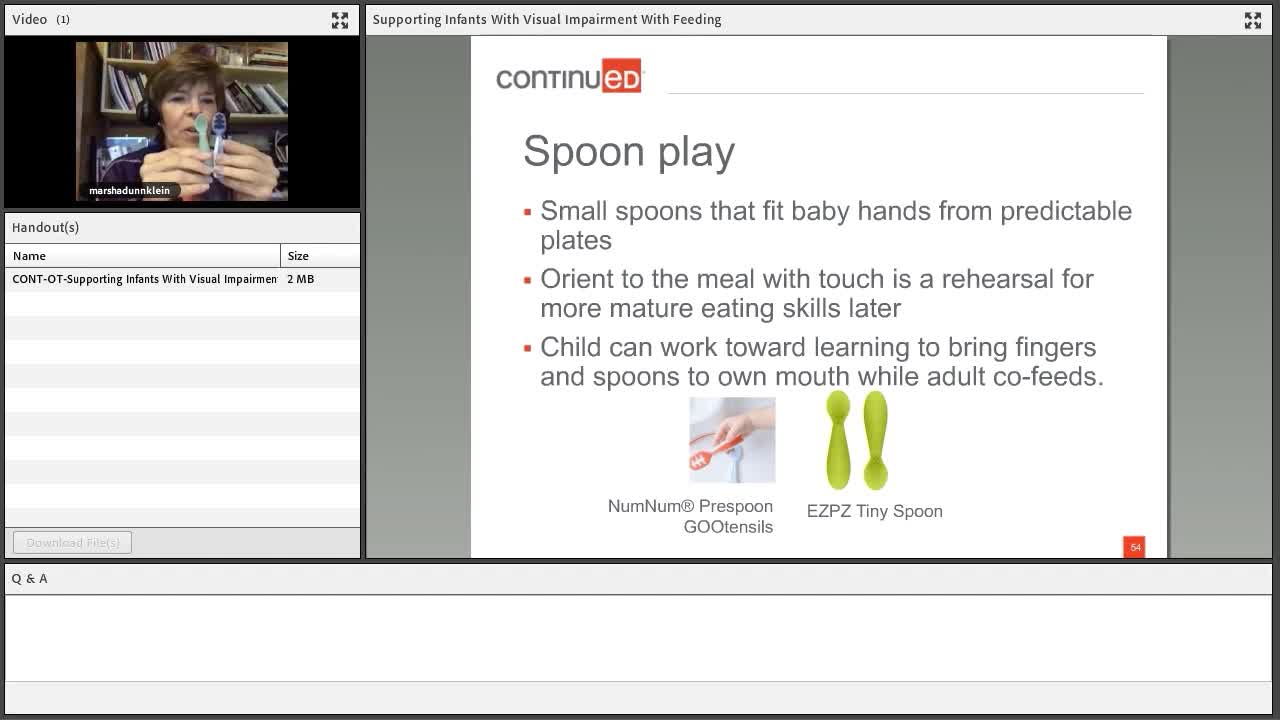
What I like about the Gootensil is that it comes with a couple of different textures. It comes with a solid one and an open one so it can be a way to give the child some texture experiences with their food. I also like the Duo Spoon as it has a texture on one end and a texture on another. The textures are different depending on which end we are using, and it is very flexible. This is a very long spoon though. This is going to be one that I am going to use to offer dipped flavors to a child with visual impairment, but it is a little harder for them to do because of its length. You want your spoon to be short and you want the wet food to easily stick to the spoon so the child can be successful with it.
For sensitive eaters, we are going to talk about flavor and taste in two different ways. If the child is gagging and worried about texture and flavor changes, you might consider going back to rubbing that spoon on foods like a pork chop, corn on the cob, a cucumber, a tomato, or an apple. This provides the flavor without texture; whereas dipping it in like a marinara sauce or baby food pears provides both texture and flavor. For children that are particularly worried, you might have to go back to separating those out because you are looking for what the child likes.
Around the Bowl
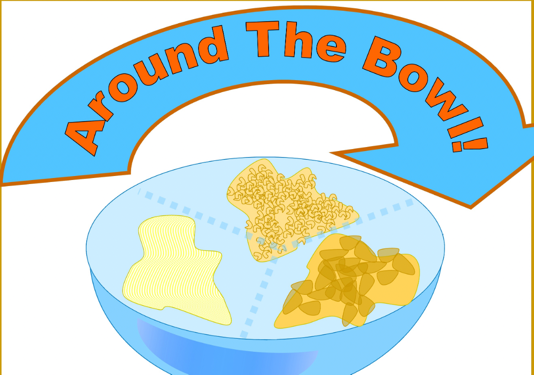
Figure 13. Around the bowl technique.
I like Around the Bowl technique for children with visual impairments (see Figure 13). I am going to start every meal with success and with something the child knows. You are not going to start the meal with a brand new food as that is a sensory surprise. "I don't know what to expect at mealtime because you're always coming at me with different things." For the adventuresome eater, this may be okay as the child shows signs of progress, but you need to build that confidence. You are going to start with a portion of food the child knows like baby food apricots. You also may add a little bit of baby cereal in it. You might add in some chopped up canned apricots so now there are some different textures. You start the meal with the baby food apricots the child knows, and then you take a little bit of the next food and offer it. You watch the child's response. If they are comfortable, you can keep offering a little more as the child is showing you it is okay. If they are not comfortable, you are going to go back to what they know. This is going "around the bowl" with their permission.
Puree Plateau
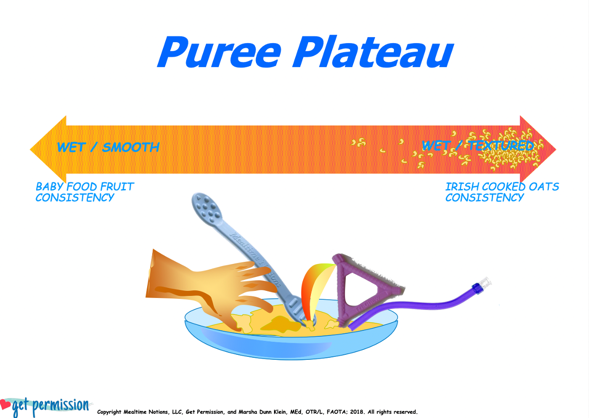
Figure 14. Overview of the puree plateau.
This plateau in Figure 14 says that purees can go from very smooth like baby food apricots to more textured kinds of foods like Irish oatmeal that is cooked and has flakes that never disintegrate. One of the things I think happens is that we have a tendency to give kids baby food Stage one, two and three, and then we want to give them solids. That is a huge leap. When you have sensory and visual challenges that do not allow previews, this leap can be a big sensory surprise. I want to make sure that we, as grown-ups who love these children, really help them have experiences that are offered slowly in an around the bowl kind of way. I have had some children who have had the hardest time moving from baby food to anything textured. I have had kids that are so worried about texture change that they will gag or vomit when those baby food apricots change in any way at all. I like to use a spoon called the Duo Spoon that has textured endings at each end. Some of the other textured spoons that are out there are the NumNum Dipper and the ChooMee Spoon. I also like feeding kids off the Tri-Chew. I generally like feeding kids off of spoons that have textures because they experience the food they know, the baby food apricots, and the textures in their mouth simultaneously. It is a way to bridge the transition to texture without leaving the texture in the child's mouth.
At the puree plateau stage, we might have the kids eat off their own fingers, off of textured spoons, or off of solid foods like a bagel or a carrot. It depends on the child's skill level, and we are going to of course supervise. We can feed them off of a Tri-Chew or a straw. The child is learning to shape their mouth around different items, and using a straw is going to be a skill that they are going to use later in life. We can use these experiences as a preview of something to come. For example, if a child likes peaches, we might give them those peaches also off the edge of a cup as a pre-cup drinking kind of experience.
Plates That Are Not Easily Thrown
- Creates a food environment for exploration
- Consider using a bowl that does not MOVE
- EZPZ example happens to be my favorite, but you may know of others
I think plates that are not easily thrown are very important. I really love the EZPZ Plate shown in Figure 15.
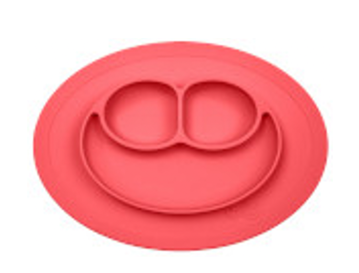
Figure 15. EZPZ plate.
They come in different sizes and shapes, for bigger kids. For smaller kids, what is great about these are they suction to the table. We cannot be spending a lot of time with the visually impaired baby knocking the bowl off the tray so these are fabulous for this population in my experience.
Combination of Spoons and Fingers
- From a predictable plate or mat
- With familiar foods and maybe new ones
- Safe textures
- Baby can explore at HER/HIS PACE
- Baby can eat until done
- Baby will demonstrate increased skill, confidence
Video 4.
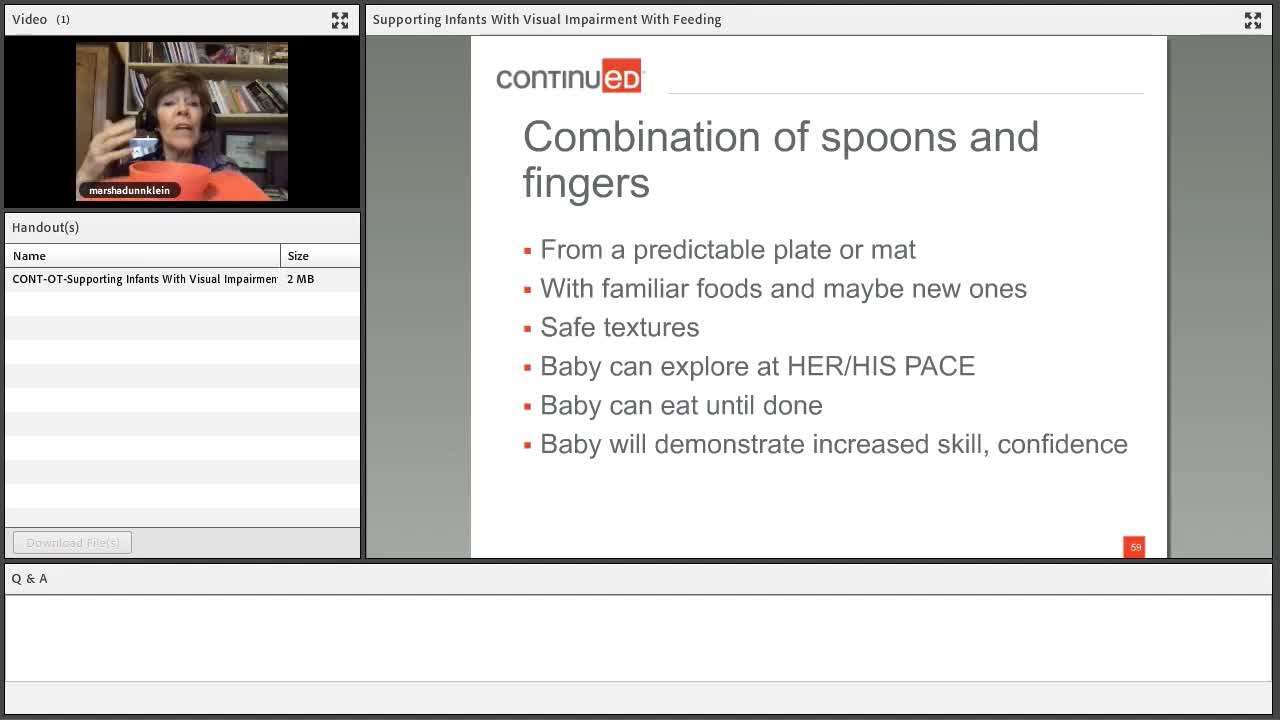
We can, from that predictable map, fill it with spoons and mouthing toys. We can put different textures around that tray and have the child explore this feeding environment. We can say to the child, "Here are your spoons and here is your food. Here are some crumbs over here." Let the child begin practice environmental exploration. They can search reach around the bowl and the edges where you have placed different foods. I like to give kids the spoon in the bowl to start with, but as kids are older, we will put the spoon in the same spot every time. We will also do this with their cup.
Expect a Mess
- But this is how babies learn
- Babies with visual challenges need all that sensory exploration and practice
- Prepare baby with plastic bibs
- Prepare floor with plastic tablecloth or mat
- Remember when the baby is being messy, she is exploring and learning!
These kids are going to be messy, as are all babies. However, these kids are particularly messy because it is harder to motor plan. We want to help parents be successful with plastic bibs, a plastic tablecloth, and mat on the floor. Have parents expect a mess instead of fighting the mess. They can prepare for it rather than worrying about it.
Picking Up Food
- Search reaching
- Bowls that do not move or on the tray
- Special feeders such as net feeders or (KIDSME) feeders
- Caution with the foods we offer so a child can manage and not be scared by choking
- The more they can do themselves the better!
Video 5.

Children are going to need help in picking up food. I really love using tools like the KIDSME Feeder or the mesh feeder that you see in Figure 16.
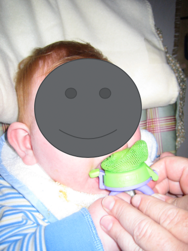
Figure 16. Mesh feeder.
There is a silicone end on this feeder, and it has handles for the child to use it as a mouthing toy. You can put all sorts of tastes and textures in this net such as peaches, a piece of pork chop, some hamburger, some macaroni and cheese, a piece of watermelon, or a pile of a puree. I love these with this population. They can do it themselves, and I love that parents can use this to figure out what their child loves.
Cups
- Open cups vs Spouts vs. indented tops
Video 6.

I like to use a variety of different kinds of cups. I like this particular cup that you see in Figure 17. It is called the Tiny Cup and is through EZPZ.
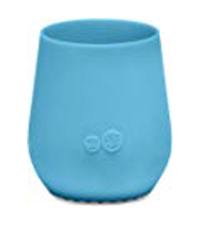
Figure 17. Tiny Cup by EZPZ.
There are lots of little ti
